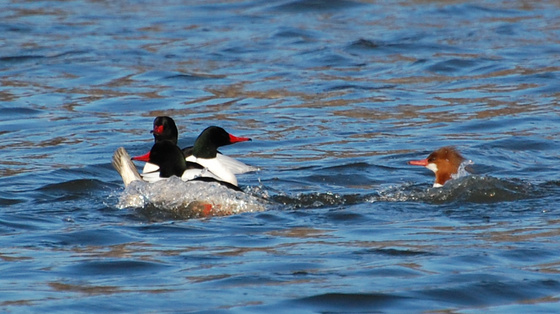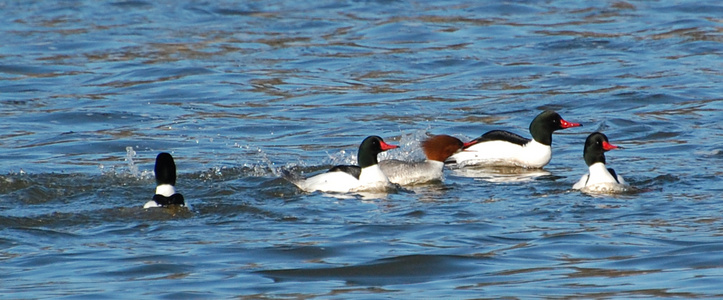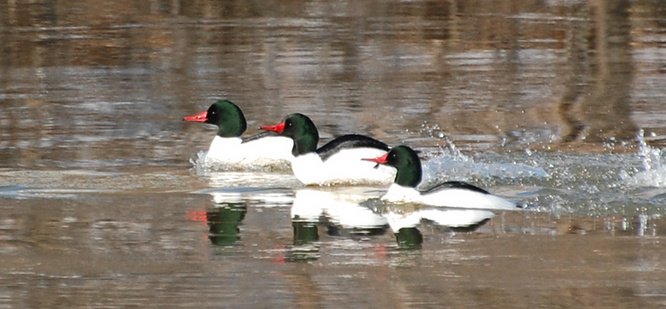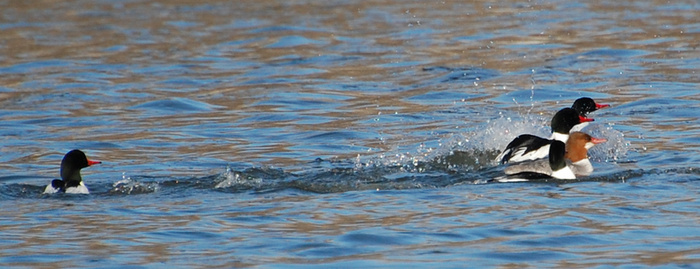
Promises
March 18th, 2010

Red-Winged Blackbird
March 17th, 2010
Just south of Cummings Bridge, on the Rideau, there's a low shore that flooded during a rainstorm this winter, then promptly froze over. The flood is thawing now, and the resulting swampy area is heaven on earth to certain birds. Mallards and gulls are loving it, grackles are loving it, redwings are loving it. They're all swimming and wading around sharing the space.
One redwing was wading in the flood looking for food, occasionally pausing to sing and flash his epaulets. Even for his species this guy was gutsy. Several times I had to dial back my lens because he was wandering in my direction and 300mm had become too much!
Also, the light on that riverbank is just glorious in the morning. I think I've mentioned this before.

1680x1050 wallpaper

1680x1050 wallpaper

1680x1050 wallpaper
"MY territory, bub--and don't you forget it!"
Hurdman Hawk
March 16th, 2010
A lone Red-Tailed Hawk is still haunting Hurdman transit station, after some weeks now.


He must be finding an abundant supply of voles in the neighboring fields. I saw him hunt once--he flew over to the hill, hovered, landed in the grass and stood motionless for some time, perhaps listening for the pitter-patter of their little feet.
The crows harass him whenever they find him. Sometimes they seem to be on patrol. I've seen them land on that hill and spread out, not foraging, just looking around and cawing.
Ah well.
With redwings and grackles back in town, it won't be long before the crows are getting a taste of their own medicine.
Mourning Dove
March 15th, 2010

1680x1050 wallpaper
Ode To Goldeneyes
March 14th, 2010
Those of you who've only recently joined me may not have heard my "goldeneye spiel" yet. So here it is:
I love Common Goldeneyes. They are my sentimental favorite of all Canadian ducks. They may not be the most beautiful of all ducks (though they are beautiful), and they certainly aren't the rarest of all ducks. They are arguably the toughest of all ducks, and for that, among other things, I love them.
Goldeneyes are diving ducks. This class of waterfowl is less familiar to most people, because they tend to be very wild and swim far from shore. Unlike "dabbling ducks" who feed by picking at the surface of the water, tipping up, or even foraging on land, diving ducks forage by submerging entirely underwater. Bird-watching with them can be an exercise in patience. If they're busily feeding, you get to watch only for seconds at a time before they go *bloop* and disappear.
Diving ducks are truly aquatic birds. Most of them never go onto land except to nest. Their adaptations for diving have rendered them ungainly in flight. They have to flap fast to stay in the air, and while a dabbler, such as a mallard, can spring right up out of the water, a diver has to patter furiously along the surface for some meters before it can lift off.
Why do I love Common Goldeneyes? Well, because they're gorgeous, for starters. Brilliant white, heads glossed with iridescent green, bright yellow eyes. None of the photos I've posted do justice to them (this is the closest I've come); these guys just don't come close enough to shore for a quality close-up, unless you've got a way longer lens than I've got. The only way to really appreciate them is with a good set of binoculars.
And because as an Ottawan I have a certain sense of...well, ownership. Common Goldeneyes are "ours" for five months out of the year. They spend the winter with us, in large numbers. The humble little Rideau River is one of their favorite wintering grounds. In fact one of the photos on their Wikipedia page was even taken on the Rideau.
And because their courtship rituals are the nuttiest thing I've ever seen. A male swims along, and all of a sudden he pops his head 180 degrees back, as far as it will go. It happens so fast you'd think he was spring-loaded.
And because they kick ass. Very few waterfowl winter inland as far north as the goldeneyes do--and most of those who do depend on humans to feed them. Goldeneyes shun humans, catch all their own food and not only survive Canadian winter, but thrive in it. Even in 30 below when the Mallards and Blacks are all huddled up on shore, hiding their faces and trying to stay warm, the goldeneyes are out there, splashing and diving and not looking at all perturbed. They can be seen, too, in the pounding rapids of the Ottawa River, braving the waves and the current.
Now it's coming time for them to head back to their breeding grounds in the north. Those wintering here will leave; others, wintering further south, will move through. Goldeneyes, like most ducks, pair off on their wintering grounds, with the pairs travelling together in spring migration.
Many males have already attracted a mate.

Others are still trying...


1680x1050 wallpaper
At least one Barrow's Goldeneye (Common Goldeneye's rare-in-the-east close cousin) is still present on the Rideau--and this time, he actually came close enough to shore for me to get some half-decent photos! I even managed to capture his indigo gloss in the second pic.


That's a female Common with him. They often seem to find these exotic males fascinating.
Serenity
March 12th, 2010

1680x1050 wallpaper
Where's Waldo?
March 10th, 2010
Arguably Canada's most well-camouflaged bird: the Brown Creeper.

Having taken about twenty shots in rapid succession, I managed to catch a profile view of this guy: a rare occasion when a creeper was somewhere other than plastered to the bark of a tree, and virtually invisible.
Creepers are another year-round species. I log most of my sightings of them in winter and early spring, when they wander in diverse habitats in search of food. Like nuthatches they're little birds that creep along tree trunks and branches, probing the bark for food. (They survive in winter thanks to the presence of hibernating insects.) Unlike nuthatches, they can't climb back down; instead, having reached the top of one tree, they fly to the bottom of the next one and spiral up again. The presence of a creeper is announced--if you're lucky--by a faint high-pitched call, similar to a chickadee tweet, but more high-pitched and drawn out.
This is what a Brown Creeper sighting usually looks like:

Courtship Follies of the Common Merganser
March 9th, 2010
Photography along the Rideau yesterday morning was out. of. this. world. The lighting was glorious and all the ducks were out in full glory, preening and courting. I took home over 450 pictures to sort through.
The undisputed star of the day was the Common Mergansers. Seven males, one female--and they all wanted her. They came rollicking along while I was watching goldeneyes at Riverain Park. They were so engrossed in what they were doing that they really didn't seem to care how close they got to me.
For many ducks, courtship has something to do with odd contortions: Common Goldeneyes and Hooded Mergansers pop their heads back, Mallards bob their heads up and down. For some reason, neck flexibility is important enough to show it off. Not so the Common Mergansers. For them it's all about speed. Perhaps it's because they're fish-eaters. Fish-eaters are more likely to have a need for speed than, say, ducks who subsist on water weeds or mollusks.
So the males race and chase up and down the river, leaving a wake wherever they go. They chase each other, they chase the female, they posture and squabble. And sometimes the cheeky female gets right into the act!


1680x1050 wallpaper


1680x1050 wallpaper


( And more... )
Some hairies
March 5th, 2010
Hairy Woodpeckers are Downy Woodpeckers' jumbo twins. They're 2-3 inches bigger, with disproportionately longer and stouter beaks, but otherwise identical. I find them more truly woodpecker-like in their mannerisms, while Downies often put me in mind of wannabe chickadees. But they're about as tame, and about as likely to show up at feeders. This one was haunting a suet feeder in the Hurdman woods, allowing me several excellent close-ups of him.


Every bird deserves its day
March 4th, 2010
Imported from Europe in the mid-nineteenth century, now scraping out a living in towns and cities across North America: the humble House Sparrow.

1680x1050 wallpaper

|
